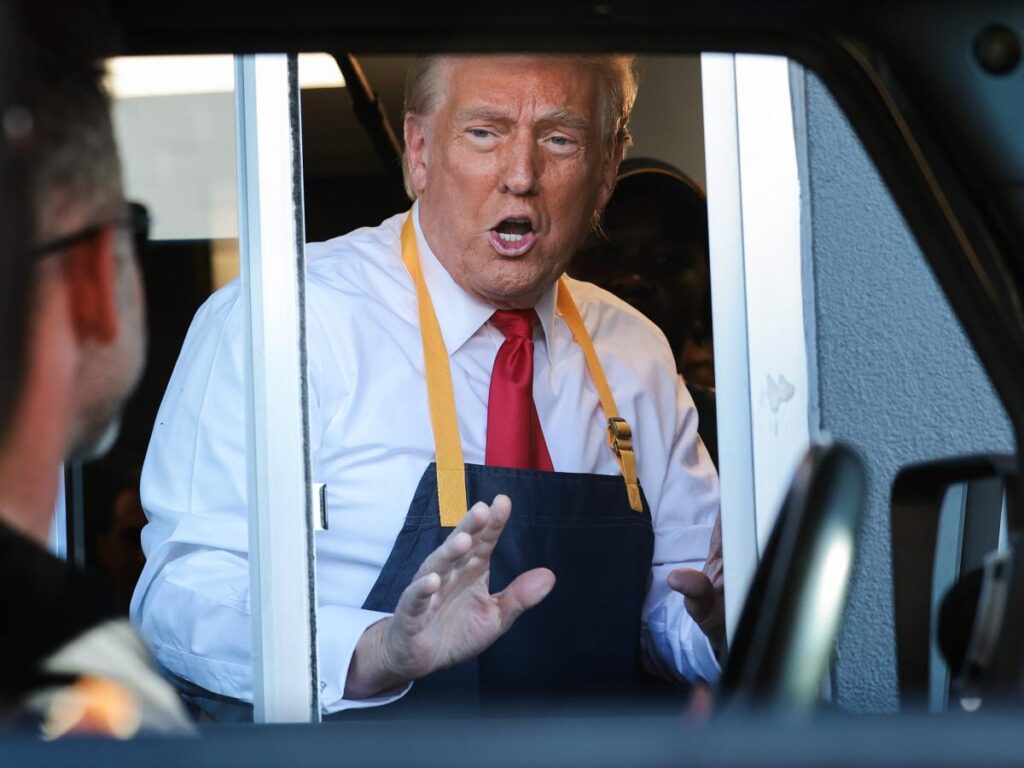On a recent visit to Pennsylvania, former President Donald Trump stopped at a McDonald’s franchise in Feasterville-Trevose, which has garnered attention for more than just his fast-food preferences. Trump’s visit comes amidst a contentious political narrative, particularly as he has made repeated claims, lacking evidence, that Vice President Kamala Harris did not actually work at a McDonald’s, a claim central to her biography. Harris asserts that she worked at a McDonald’s in Alameda, California, during the summer of 1983 while attending Howard University, frying fries and operating the cash register. Trump’s skepticism is part of a broader strategy to undermine Harris’s credibility and appeal as a candidate in a highly competitive political landscape.
As Trump engaged with customers at McDonald’s, donning an employee apron and participating actively by handing out orders and cooking fries, his actions seemed less about enjoying the food and more about establishing a narrative that runs counter to Harris’s claims. At a rally in Detroit, Trump labeled Harris as a liar regarding her employment history, a sentiment echoed by his senior advisor, Jason Miller, who suggested that Trump’s visit was intended to contrast the work experience of the candidates, insinuating that he is a legitimate candidate with genuine work experience. This move is indicative of Trump’s strategy to attack his opponent’s authenticity while promoting a working-class image that he believes will resonate with voters.
Harris has responded robustly to Trump’s allegations, framing them as desperate tactics from a candidate who may not fully grasp the meaning of hard work due to his privileged background. The Harris campaign has utilized her McDonald’s work experience to paint a picture of relatability and emphasize her middle-class upbringing compared to Trump’s affluent lifestyle. Harris’s representatives argue that Trump’s claims come from a place of ignorance and inability to comprehend the challenges faced by the average American, as they seek to create a contrast between the two candidates.
The political stakes are high as the race tightens, with both candidates battling over economic issues that were once a strong point for Trump. After Joe Biden withdrew from the race, Harris took the opportunity to challenge Trump on these very grounds, effectively narrowing the gap in swing states. Both candidates have recognized the relevance of public perception and personal history, leveraging stories from their past to appeal to voters, particularly regarding employment and economic savvy, which remain critical issues in their campaigns.
Within this context, McDonald’s plays a dual role in the narrative being constructed around both candidates. As the world’s largest fast-food chain, McDonald’s isn’t just known for its hamburgers and fries; it is also a significant employer in the U.S., with a large workforce that includes individuals from various backgrounds. The owner of the McDonald’s where Trump visited expressed pride in showcasing the franchise, underscoring the store as a place of opportunity—a sentiment that both resonates with and contrasts against the political battle unfolding. Derek Giacomantonio’s statements highlight the fast-food experience as foundational for many American workers, offering a crucial support structure that could positively influence perceptions of Harris’s past employment.
Trump’s longstanding affinity for fast food is well-documented, amplifying the symbolism of his visit to McDonald’s. From his infamous Big Mac photo on his private jet after securing the GOP nomination in 2016 to feeding college athletes an array of fast-food meals during a White House event, Trump has built an image around American fast food culture. His strategies suggest that he continues to appeal to the average voter through shared experiences about productivity and labor, regardless of whether he has tailored that image to align with his own privileged background. This blend of personal narrative, public perception, and political strategy is at the core of the ongoing contest for the presidency, where both candidates are working to reframe their legacies and present relatable images to the voters.

